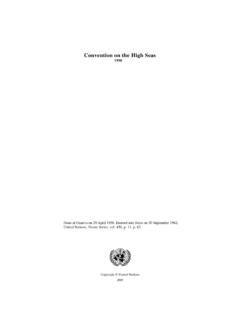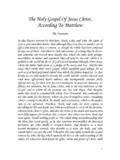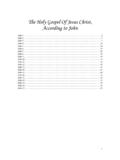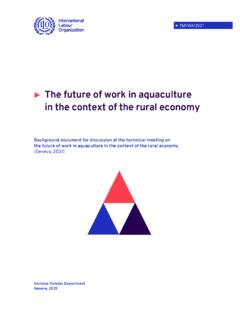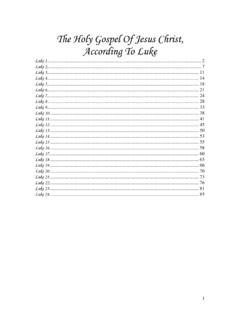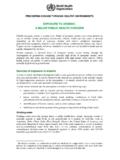Transcription of STABILITY STUDIES IN A GLOBAL ENVIRONMENT Geneva, 13 …
1 Working document with comments RESTRICTED WORLD HEALTH ORGANIZATION ORGANISATION MONDIALE DE LA SANTE STABILITY STUDIES IN A GLOBAL ENVIRONMENT geneva , 13-14 December 2004 RECOMMENDATIONS AGREED BY THE MEETING 1. The existing WHO guideline on STABILITY testing should be reviewed in the light of new information on climatic conditions in Zone IV as raised by the ASEAN countries. 2. All concerned parties represented at the meeting should return to their constituencies, consider the options that were discussed, and provide feedback and recommendations to WHO, indicating preferences and giving reasons. Those parties will be invited to be involved in the continuation of the consultative process. The options are: In December 2004 a meeting was organized to discuss STABILITY STUDIES in a GLOBAL ENVIRONMENT . Details thereon, including the agenda, list of participants and recommendations, can be found on the web site: ( ) The current document summarizes all comments received to date on the third options proposed at the above meeting.
2 These comments will be presented to the forthcoming Expert Committee on Specifications for Pharmaceutical Preparations for discussion on the next steps to be taken. We should like to take this opportunity to refer to WHO's constitutional mandate to collaborate with all Member States, members of its Expert Advisory Panel, Collaborating Centres, nongovernmental organizations (NGOs) and other interested parties in a harmonized approach in the area of standards in quality assurance. Working document with comments page 2 A. Revert to 30 C/70%RH as the long-term STABILITY testing condition for Zone IV as it is likely that considerable data are already available. This might serve as a potential platform for future harmonization between ICH and WHO. B. Change to 30 C/75%RH as the long-term STABILITY testing condition for Zone IV in the interest of patient safety worldwide. C. Add a new climatic Zone IVb to accommodate hot and very humid areas (30 C/75% RH).
3 The present Zone IV (30 C/65%RH) would become Zone IVa. Feedback was requested by end March 2005 at the latest. WHO Member States not represented at the meeting were also invited to give their feedback. 3. WHO should make the meeting materials publicly available via the WHO website, including the agenda, slide presentations, list of participants and their affiliations, the key points that were discussed, and the agreed recommendations. FEEDBACK SUBSEQUENT TO THE MEETING ON STABILITY STUDIES IN GLOBAL ENVIRONMENT , 13-14 DECEMBER 2004 Indonesia would recommend option B to be applied in WHO Guidelines that is: change to 30 C/ 75% RH as the long-term STABILITY testing condition for zone IV in the interest of patient safety worldwide. The reason for recommending this option is because it is the most suitable condition for ASEAN climate and the 9th ASEAN Consultative Committee for Standards and Quality (ACCSQ) Pharmaceutical Product Working Group (PPWG) Meeting, February 2005 held in the Philippines, decided to stick on this option.
4 I would be delighted to hear conclusion made by WHO as the result of recommendation gathering from all parties. Dr L. Slamet, National Agency of Drug and food Control, Indonesia With regards to the real time testing for ASEAN the chairman agreed that ASEAN keeps to the decision made at the 9th ACCSQ PPWG Meeting, 22-24 February 2005, Philippines. On item 23(Agenda Item ) the report of the 9th Meeting of the ACCSQ PPWG says that the meeting agreed to the proposal made by Indonesia and the Focus Discussion Group that "ASEAN to stay with the current real time and storage condition of 30 C/ 75% RH". Hence this decision made would fall into option B: change to 30 Working document with comments page 3 C/ 75% RH as the long term STABILITY testing condition for zone IV in the interest of patient safety worldwide. With this the chairman would like the option B to be considered by WHO as ASEAN position which was the decision made at the 9th ACCSQ-PPWG and also support the position of Indonesia being the lead country for ACTD-Quality in particular on the Guidelines on STABILITY STUDIES for ASEAN region.
5 In addition Malaysia too agree with the decision made at the 9th PPWG Meeting the current real time and storage condition for ASEAN is 30 C/ 75% RH" which would falls into option B -establishing a GLOBAL set of conditions for STABILITY testing in hot & humid climates. Dr F. Ariffin, National Pharmaceutical Control Bureau, Malaysia WSMI member companies have considered the options provided by WHO (listed below) following the December 2004 meeting to discuss STABILITY conditions to support hot and humid regions (Climate zone IV). A Revert to 30 C/70%RH as the long-term STABILITY testing condition for Zone IV as it is likely that considerable data are already available. This might serve as a potential platform for future harmonization between ICH and WHO. B Change to 30 C/75%RH as the long-term STABILITY testing condition for Zone IV in the interest of patient safety worldwide.
6 C Add a new climatic Zone IVb to accommodate hot and very humid areas (30 C/75% RH). The present Zone IV (30 C/65%RH) would become Zone IVa. In terms of the 3 options presented, our preferences are as follows. First (Option A). To use 30/70 as the condition for all Zone IV countries. This option comes with the caveat that it becomes the single WHO condition for all countries in the agreed Zone IV. Where this is not the case and some countries within Zone IV still require testing at 30/75, Option C (second preference) becomes the preferred option. If the 30/70 option is agreed, it is proposed that ICH should change the intermediate condition in Q1AR to 30deg and "at least 60% RH" (with a 5% engineering tolerance). Companies can then choose to run their STUDIES under higher conditions ( 70% RH if they so wish) and therefore have a single intermediate & Zone IV long term condition.
7 Working document with comments page 4 This option together with the proposed amendments to the ICH intermediate condition presents an opportunity for a GLOBAL STABILITY package thereby enabling timely access to new medicines in all territories of the world. Second (Option C). To use 30/75 as a Zone IVb condition for markets with very humid conditions, with Zone IVa continuing to accept 30/65 as their condition. We continue to believe that the actual conditions in the majority of countries in Zone IV are adequately addressed by STABILITY STUDIES conducted at 30 C /65% RH as a long term STABILITY test condition, and that only a minority of countries (very humid) may wish to consider long term STABILITY testing at 30 C /75% RH. This would mean that the standard GLOBAL STABILITY package, generated according to the ICH STABILITY guidelines (30/65), would still meet the long term STABILITY testing requirements of the majority of countries, apart from those in Zone IVB (very humid).
8 However, we recognize that the specific data STABILITY data requirements for Zone IVB countries would still need to be met; but this could be achieved by supplementing the GLOBAL STABILITY data package with appropriate STABILITY data at 30/75. If this option is agreed, then WHO should prepare an agreed list of the small number of countries that would be placed in the more humid zone IVb. Only a minor revision to ICH Q1F, to reflect the new Zone IVB would be required and no change would be required to the current ICH Q1AR2 conditions, therefore this option has the advantage of not requiring yet another change to current GLOBAL STABILITY testing conditions and also a minimum change to the ICH guidelines. This option allows STABILITY data to be generated to specifically meet Zone IVb (very humid) conditions without imposing these more stressful humidity conditions to Zone IVa markets thereby minimizing the potential risk to shelf life and the need for more protective packaging and thus the impact on cost to a smaller number of markets Third (Option B) To use 30/75 for all Zone IV countries.
9 This option is strongly opposed as it could lead to the need to provide expensive and over-protective packaging for countries that do not need it, leading to higher costs and a higher packaging disposal requirement. Such conditions (75% RH) if imposed for all Zone IV markets would subject drug product to much harsher storage conditions than would be absolutely necessary according to measured conditions for a number of Zone IV markets and could lead to an adverse effect on product specifications, shorter shelf-life and increased costs resulting from over protective packaging. In proposing a specific STABILITY condition for one region only this negates the acceptance of a GLOBAL STABILITY package. This could impact on the availability of Working document with comments page 5 medicines delays in submission or shortened shelf-life products and therefore have an impact on patient access to medicines.
10 If 30/75% is adopted for WHO Zone IV despite the opposition of Industry, then WSMI suggests that ICH conditions use the wording 30degC not less than 60% RH (similar to above) Other Information Whichever recommendation is made, it must be on the assumption that it becomes the single WHO condition for all countries in the agreed Zone IV. We would not expect to see the possibility that countries could adopt other testing conditions if they so wished. If the Zone is split into two, then WHO should prepare an agreed list of the small number of countries that would be placed in the more humid zone IVb. New STABILITY requirements introduced as a result of revised Zone IV conditions should take into account the totality of the STABILITY data available for a product (including pharmaceutical development, drug substance STABILITY and STABILITY data under ICH conditions).










